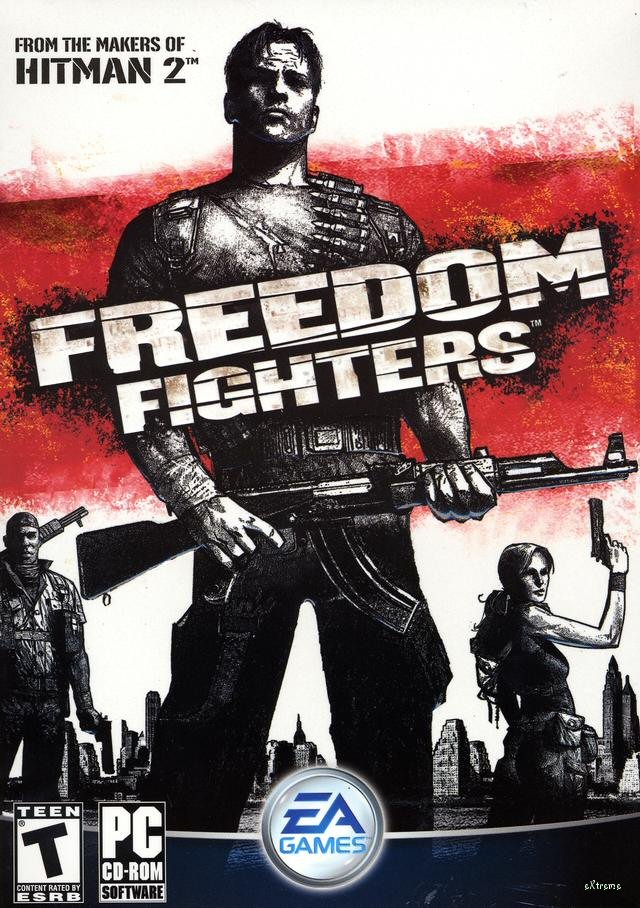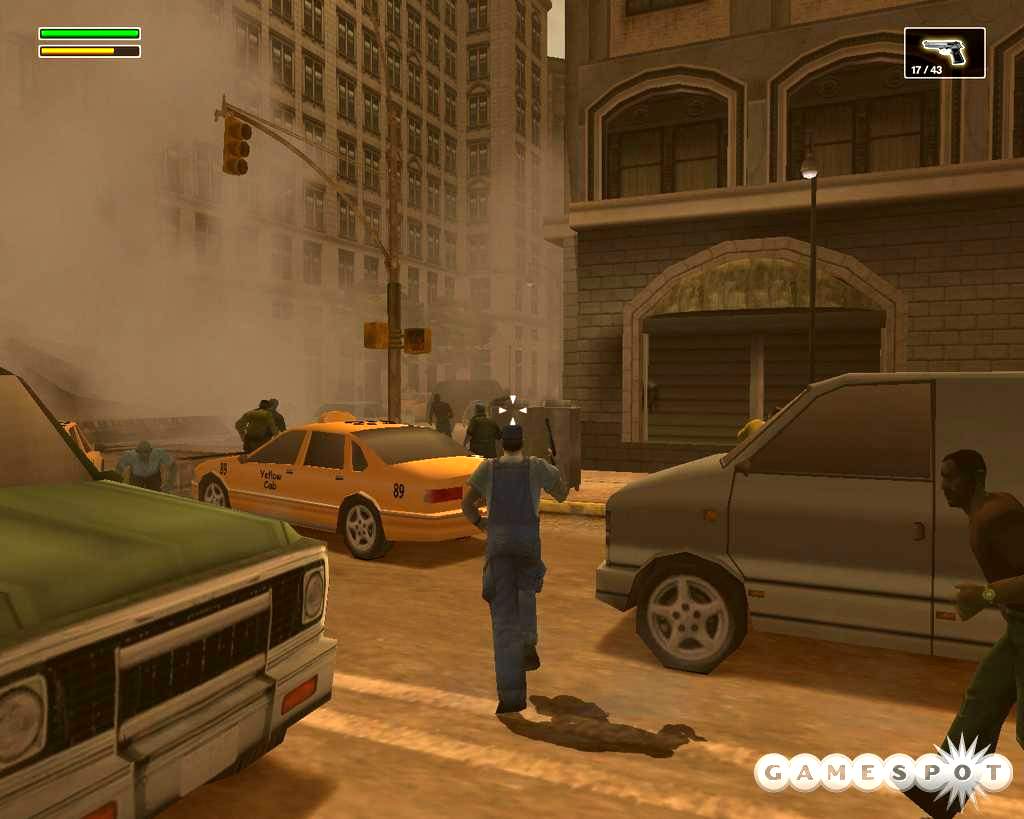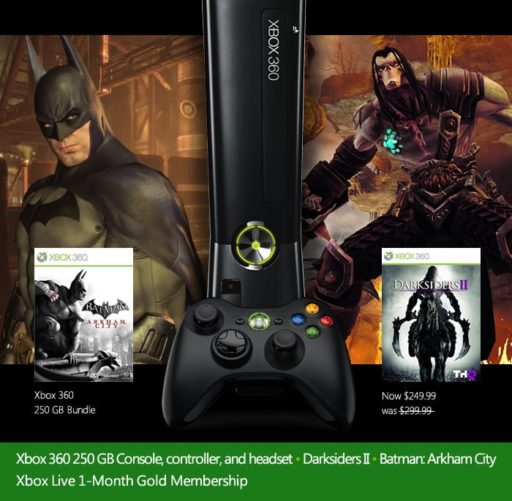What if WWII didn’t end the way it did? What if the Soviet Union brought an end to WWII by dropping an atomic bomb on Berlin? What if the Soviets invaded the United States? What if New York City, as a whole, was invaded? This is how my favorite game of all time, IO Interactive’s Freedom Fighters, begins……..
Freedom Fighters is a third person shooter, putting you in the hands of a plumber and his group of fellow freedom fighters, as they try to win back NYC and restore peace. The gameplay works in a style vaguely similar to the Battlefield franchise’s “Conquest” mode, and gives you a map before each level, showing you the individual buildings that need to be taken back. How and in what order you do this is completely up to you, which is where part of the fun comes in.
Back when it was released in the holiday season of 2003, Freedom Fighters looked like it could be a bit of an embarrassment. The cover was almost hilariously over-American – rough sketches of military figures against a red, white and blue colored backdrop of New York City, who were fighting to save our dear precious nation from foreign invaders. By this time, the word “freedom” itself had become something of a loaded term, used to stir feelings of patriotism to excuse America’s more questionable actions.
So Freedom Fighters reeked of post 9/11 exploitation, trying to sell itself on the fear and paranoia instilled in our country by the terrorists. To the tin hat wearing crowd, it almost might seem like it was propaganda in video game form. It didn’t help that Electronic Arts’ name was on the box. Electronic Arts may once have been semi-reputable, and they still occasionally put out some okay games, but they seem like the kind of shameless-money-hungry-quality-be-damned corporation that would put out pandering shlock to fill our country’s needs to kill foreigners under the pretense of truth, justice, and the American way (for an honest to God example, see Fugutive Hunter, where you can kick Osama bin Laden in the balls, if you’d like.) Ironically, Freedom Fighters is probably the highest quality game to come out of EA in a damn long time.
Every level has three buildings to take over, and these are placed in a giant chunk of the city, completely open for you. Some buildings may require you to do a separate task first, such as blowing up the foundations of a billboard that two snipers are perched upon. You can also have squadmates that you can command with three buttons: Hold, Attack, and Defend. You can have everyone hold by holding down the hold button, or tap it 6 times to have 6 people hold. Aim at an enemy and hold the attack button down and everyone charges for him, or you can assign an enemy to each squadmate.
The quality of Mirror’s Edge, as a game, is open to debate. Its forced combat sequences were an uncomfortable fit for the game’s smooth and captivating parkour style. Its story flirted with profundity without backing up its characters with interesting history or true emotion. Still, the premise was sound: A dystopian future in a sterile urban setting where freedom of thought, speech, and even physical movement are closely monitored by a police state that rules through physical and psychological intimidation. You fill the role of a young idealist, fighting the system by getting out The Truth through — in theory — non-violent means. Faith is instantly likable, someone we can empathize with because of her position as a revolutionary and defender of freedom. That identification gives the play sequence described above even greater urgency.
Rhianna Pratchett, writer of Mirror’s Edge, describes Faith as a freedom fighter who is transformed by oppression affecting her family. “Faith doesn’t really start as a fighter. The Runners are somewhere in between the powers that be in the city and those that oppose them. They are facilitating a need, rather than leading a charge. Faith’s parents were heavily active in opposing the changes in the city. Faith’s familial ties to the city prevent her from leaving, so she is just trying to get by in a job she loves, without getting into the politics that brought it about. Most of us are like that; we aren’t fighters. When push comes to shove and Kate [Faith’s sister] is under threat, Faith realizes that she has to step up to the plate or risk losing everything.” Faith’s task is one that matters. She isn’t raiding a tomb hunting for treasure, and she isn’t engaged in some fantasy blood sport broadcast as reality television. That’s what makes her work as a character and, forgiving its structural problems at a design level, that’s what makes the game work too.
Now, the real reason that Freedom Fighters was such a favorite of mine, was because of its implementation of something that is far too scarce from modern day gaming: cheat codes.
FF had a great selection of cheats, from “Fast Forward Action”, which sped up the entire game by 200%,”Fly-Mo”, which caused every death from an explosion to go down in beautiful slow mo while the world around them still moved at a normal speed, “Infinite Ammo” + any of the weapon cheats, “Blind as a Bat”, which removed vision from enemies, but still had them fire blindly, or “Nail Gun”, which pinned every dead enemy to the walls, in all their ragdoll glory. In fact, I think one of the reasons I latched on to FF so much was because it was one of, if not the first game I played which featured ragdoll support. Did I mention every single cheat code(what is mentioned above isn’t all of them, by the way) can be combined for maximum hilarity?
Anyway, the game more or less tanked. If it had come out two years earlier, right after the attacks…well, it’d still seem skeezy, but at least it probably would’ve sold. But in those two years between 2001 and 2003, a good part of the nation was beginning to grow tired and bitter — comedians and rock bands built their acts on anti-Bush propaganda (see: the burgeoning popularity of The Daily Show, and eventually The Colbert Report, as well as Team America: World Police), and our small tiff with the French resulted in snarky college students in blue states across the nation sarcastically ordering “freedom fries” at their local diner, making me wonder if our grandparents were this cynical when sauerkraut was redubbed “liberty cabbage” during World War II. I’m sure there were other reasons for its failure – it was a busy holiday season, and other critically acclaimed titles like Ubisoft’s Beyond Good and Evil also got left behind – but one can’t help to think that maybe Freedom Fighter’s perceived political agenda may have put off the more liberal gamers.
On paper, the concept is this: the Soviets have invaded America and taken away our freedom, and must be killed. Fine. Ever since Operation Desert Storm in the early 90s, American action movies have been posing Muslims as “the bad guys”, but in this situation, there’d be no way that any video came company would let that happen, especially with all of the heat that Grand Theft Auto had taken (you know, video games inspiring violence, etc etc), in addition to all of the real life violence against Muslim-Americans across the country. But what about the Soviets? The Soviets were our favorite bad guys in the 80s, but ever since the crumbling of the Berlin Wall, no one’s really taken them seriously. The Cold War ended up sorta fizzling out, and our old enemies just kinda faded away into nothingness, making us wonder exactly why we were so afraid of to begin with. So why not use them as placeholders, instead of, say, Al-Qaeda? It must’ve made sense to the Electronics Arts exec that gave the greenlight to Freedom Fighters.
So it probably came as a disappointing surprise when Freedom Fighters actually a biting criticism our government’s foreign policies, posing as an all-American patriotic shooter. In other words, it was incredibly sneaky.
One of my proudest moments in gaming was sneaking up on top of a fire station behind an enemy with no vision, throwing a grenade by his feet, watching him lift off in super so-mo, then proceeding to raise the American flag on the building(securing that building), running down 14 floors of the building I had previously cleaned of enemies, running out front, and continuing to shoot the same guy who was still falling in so-mo until his body reached the pavement. The reason I am so proud of this moment, is, after witnessing it go down, my grandfather proclaimed, and I shit you not, “Wow…you gotta be proud of that. How did you pull that shit off?” My grandmother then proceeded to say his full name is a angry tone , reminding him that I was not supposed to hear that type of language. A proud moment indeed.
Faith is hardly alone in the gaming landscape. The defender of freedom is almost as common a game protagonist as the anthropomorphic critter with an attitude. We’ve been playing through their adventures for thirty years now. Many of the classic shooters made by Konami, Capcom, and others for the NES and arcades back in the 1980s were Cold War-fueled kill fests drunk on jingoistic jargon and pyrotechnics. Jackal, Rush’N’Attack, Bionic Commando, and even complete fantasies like Strider were all predicated upon their heroes defending freedom, and rescuing other freedom fighters from oppressors, dictators and sinister governments. We’re still seeing the legacy of those games and their protectors of the people in games we play right now. Last month’s Transformers: War for Cybertron is popular because robots that also turn into cars are awesome, but what is the narrative foundation for allowing us to play as said robots? Optimus Prime and the Autobots are trying to stop Megatron and Decepticons from turning their entire robotic society into a fascistic nightmare. Megatron wants to exert his will over all, so it’s only right to oppose him. As Optimus Prime says, “Freedom is the right of all sentient beings.”
Anyway, if you want, you can technically take Freedom Fighters at face value, which is probably what the publisher was hoping. When you start the game, you’re introduced to two Brooklyn plumbers named Christopher and Troy Stone. (Whether this is meant to parallel the Mario brothers or simply an excuse to bash people with a wrench, I’m not entirely clear.) When driving back to your apartment, the Commies stroll right on in, and they’re taking their invasion seriously. They’re not content to simply firebomb the city – they’ve brought in their tanks and helicopters and soldiers, and actively overthrowing the nation from the ground up. As Chris, you manage to escape, and someone end up leading rebel insurgence team intent on fighting against the Russian invaders. You run around parts of the city, kill some Commie bastards, and save the lives of the injured. You can interpret the whole thing as typical near-futuristic military Tom Clancy/Harry Turtledove-type drama, and it’d make sense.
There’s really a lot more beneath the surface though. The intro cutscene doesn’t go into details, but the manual fills you in on the backstory – apparently, the Soviets beat us to the punch and crushed the Nazis in World War II, allowing them to become a global superpower. They conquer the rest of the continent while America finds itself becoming increasingly irrelevant on the world stage. Sixty years later, the Soviets invade our country under the pretense of saving us. From what, exactly? The invaders claim to be saving us from an empty and vapid culture. More specifically, they’re saving us from democracy, having in their eyes failed compared to the glories of communism. But what’s their true motivation? Do we have precious natural resources that the Soviets desire? Are we covertly harboring weapons of mass destruction? Or, as the game seems to imply, are we simply the next stop on their way to world domination? We don’t know, and we’re never explicitly told. The role reversal parallels to America’s real life situation during Operation Iraqi Freedom – or hell, even Vietnam – aren’t exactly subtle, even they don’t entirely match one-for-one. Only the most ardent conspiracy theorist would suggest that modern day America is out to dominate the whole world, but the rest of the comparisons are pretty eerie.
In order to win most of the stages, all you need to do climb on the rooftop of the designated building, take down the Russian flag, and hoist the stars and stripes in its place, which immediately clears the level. It doesn’t matter whether you’re totally surrounded by bad guys and essentially cornered – apparently the sight of Old Glory has the power to cause all neighboring bad guys to simply throw down their arms and go home. It’s an unintended side effect of being a video game, but in the satirical context of Freedom Fighters, it’s really feels more like an exaggeration of the power of American ideals, like simply showing up to the battlefield will earn us victory. Ultimately, it’s making something of a mockery of our perceived power, and it’s not exactly comforting.
Why we respond so strongly to stories about struggles for freedom is obvious. Bad guys know what’s best for everyone and look to control them, good guys know that the people should be allowed to choose the life they want. We see that maxim repeated in almost all of our genre fiction regardless of medium. Why is Darth Vader a jerk? Because he blows up planets when they disobey him. Why do we like Princess Leia? Because she believes in democracy while wearing a metal bikini.
There are other bits of commentary that couldn’t have been intentional, but are pretty damned amusing in context. The Soviets decry American society (much as the rest of the world does in real life) as being lazy. Occasionally you’ll run into allies in the middle of fire fights and join, but more often, you’ll simply find them standing around like confused lambs, unwilling to fight until they do something for themselves. In one stage, you even find a few injured citizens begging for help, and yet there are med kits waiting to be picked up only a couple of feet away.
There are other bits of commentary that couldn’t have been intentional, but are pretty damned amusing in context. The Soviets decry American society (much as the rest of the world does in real life) as being lazy. Occasionally you’ll run into allies in the middle of fire fights and join, but more often, you’ll simply find them standing around like confused lambs, unwilling to fight until they do something for themselves. In one stage, you even find a few injured citizens begging for help, and yet there are med kits waiting to be picked up only a couple of feet away.
A huge credit goes to composer Jesper Kyd, who’s one of the best video game musicians working in the industry today. I’ve never seen the inside of this guy’s studio, but it must be packed with Vangelis albums. His music works on the same level as the game — it channels 80s movies soundtracks but never ends up becoming cheesy. His fast paced techno beats are blended with both synth orchestration and the Slavic chants of the Hungarian Radio Choir. It conveys a sense of foreign dread, while managing to be both tense and exciting, enough to get your blood pumping when you’re fighting Ivan, and enough to creep you out in the calmer moments. The low key Rebel Base theme is the perfect backdrop to each mission briefly, the voices of your commanders echoing in the underground waterways of your makeshift base.
The question of freedom fighters and their role in game design isn’t quite as clear. Why are they so prevalent in games? What do freedom fighters offer game designers that other protagonists in other types of stories do not? What, in particular, does the revolutionary offer a designer in play, in setting, in character, and in appeal to the audience that they wouldn’t have otherwise?
Even without cheat codes, Freedom Fighters is a great game, with a memorable storyline and incredible level design. There is even splitscreen multiplayer, which was a favorite among my friends, and still is, which puts two leaders(the players), each with their own army of around 20 clones, to destroy each other while overrunning vacant buildings.Freedom Fighters has provided over 200 hours of gameplay from me, and is just plain fun. It is a great, underrated title that is always guaranteed to produce a few laughs, and help fight back in the face of boredom. I strongly suggest you pick it up for your Xbox, PS2 or GCN. It is filled with replayability , and it is the reason why my Gamecube, every once and a while, still gets an Instant Replay.
Resources :1up.comdestructoid.com,hardcoregaming101.net









Pingback: Freedom Fighters - TheTechJournal.com (blog) - Parkour PAC
my game is nt working..dunno y
m using window 7
my game is nt working..dunno y
m using window 7
“By this time, the word “freedom” itself had become something of a loaded term, used to stir feelings of patriotism to excuse America’s more questionable actions.”
This article was written by a hippie